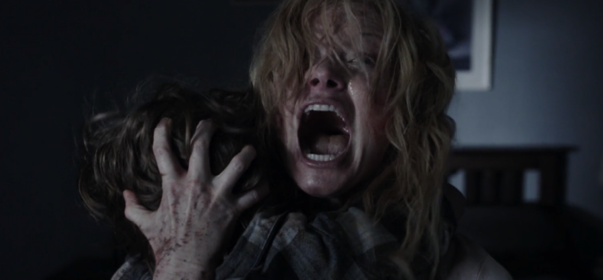


































































































































You Are Trespassing in My House:
The Taming of the Male Gaze in The Babadook
I absolutely love this movie. I wasn't quite sure about it at first because of the slow and
steady development of the story, but it's well worth the wait to get to the scary stuff
(which genuinely inspires horror and terror throughout). What I like best about the film
though is Amelia. She is not your typical horror film female -- sexual object, body in the
throws of ecstasy, the monstrous feminine, etc. -- she is a diverse character going
through an intense period of emotions after her husband's death. We see her at work
interacting with her colleagues, raising her son Samuel alone, in meaningful
conversations with her sister and neighbor, and we even get a glimpse of her sexual
frustrations in the scene where Samuel interrupts her while she's masturbating. These
are important characteristics that strengthen our sense of identification with her, but the
film offers much more than a complex female protagonist undergoing emotional trauma,
particularly when you consider the subversive treatment of the father figure.
The father is typically a symbol of power/authority in horror films, and at the beginning
of The Babadook we learn that Amelia's husband is dead. This is not a terribly new idea, as
a lot of horror films start out this way (the absent father as a symbol of patriarchy in
crisis), but usually, the film will introduce some kind replacement (priest, boyfriend,
lawman), or the father returns, and so forth, so that the symbolic order can be properly
restored. As the Babadook intrudes into Amelia and Samuel's life (with the Bbd as an
obvious metaphor for her grief after the passing of her husband), the Bbd and the father
are coupled together as a symbol of patriarchal authority. Amelia must overcome this
demon/husband, and she does so by directly defying him at the films' end. He screams at
her, and she screams right back (to the point where glass shatters!), ordering him to
leave her house. He flees to the basement, where he will always be kept (grief will always
be there, just repressed, offering a progressive spin on Robin Wood's notion of the
restoration of repression), and she can go there to visit whenever she needs to. This is
key, because patriarchal authority will always be subordinate to Amelia/the mother. The
Bbd/father/grief will always be under her control. Furthermore, the final images of the
film are of her and Samuel embracing one another; a representation of Julia Kristeva's
semiotic chora (the space of mother/child symbiosis), and a symbol that she has denied
the restoration of patriarchy.
The fallibility of the father is also represented visually in the film, which functions to
subvert the male gaze (Laura Mulvey's contention of the presumed male spectator in
cinema). Throughout the film our identification lies with Amelia, however, the
Bbd/father's haunting in the film signifies his attempt to reclaim the gaze. The primary
example is the device of the POV shot, which is used three times in the film; 1) when
Amelia is possessed by the Bbd/father, 2) during the final confrontation with the
Bbd/father, and 3) at the end when she visits the Bbd/father after he has retreated to the
basement. The first instance represents his attempt to regress Amelia into the typical
horror film female, and the second two instances are especially key, as they occur during
the moments when Amelia asserts control over her grief. Subjective shots like this are
typically tied to the male perspective in films, so by positioning us directly as the
Bbd/father in these key moments, and then having Amelia confront and defeat him,
Amelia is effectively "taming" both patriarchy and the gaze. The Babadook is ultimately a
story about symbolic figures in crisis, and their failure to assert their authority and
re-establish control of the gaze. Amelia shouts them down, renders them impotent, and
goes on to live “happily ever after” with Samuel in the semiotic.
posted on 06/16/15 by apw